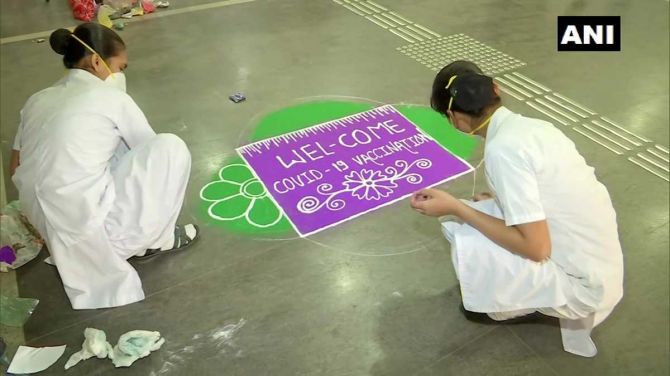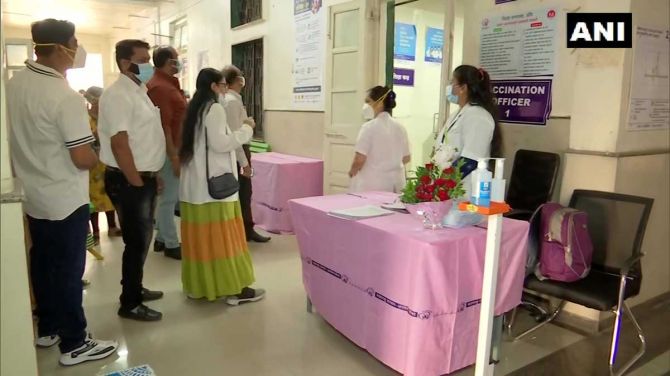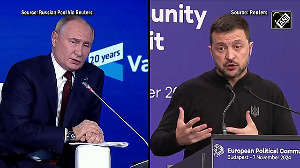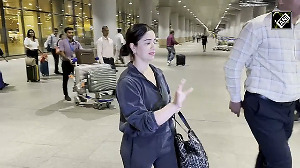'We are already exhausted, but we can't give up.'
'The battle is still on.'
'We will see some respite by December 2021.'

Pune, says Dr Sanjay Lalwani, medical director of the city's Bharti Vidyapeeth hospital and medical college, is one of the metros in India that has had the fiercest vaccination drives against COVID-19.
More numbers have turned out to vaccinate in this city of 6.8 million*, than other places and by April 5, 10.5 million vaccines** had been administered.
Yet Pune today is one of the worst affected by the COVID-19 pandemic, because, Dr Lalwani feels, in spite of its strong vaccination numbers, the nationwide vaccination strategy -- which only allowed first those over 60 to vaccinate from March 1, and then those over 45 to vaccinate from April 1 -- did not come strongly and widely enough into place, in time, and the rate of vaccination has been way too complacent.
So, for Pune, it's still a case of too little, too late.
As of April 9, the city is buckling under the pressure of 10,000-12,000 residents turning positive every day, that is resulting in an acute shortage of ventilated hospital beds and a chaotic, impossible crisis across Pune, that needs solutions at once.
Dr Lalwani, professor of pediatrics, a practicing pediatrician, whose unit at Bharti Vidyapeeth was where, last August, the first trials of the COVID-19 Covishield vaccine took place, believes the way forward for Pune is to call for a short, more severe lockdown and then alongside, on the double, accelerate the vaccination.
But he warns that a Pune-like situation can be replicated all over the country, if city administrations, state governments and the Centre don't act with alacrity to curtail the fast-expanding surge.
And if vaccination doesn't take place on a war footing.
In Part II of his interview to Vaihayasi Pande Daniel/Rediff.com, Dr Lalwani alerts us to the fact that this new variant of COVID-19, which is in operation, does seem to be affecting children much more and how difficult that makes it for families.
For this pediatrician, like all our stalwart doctors across the country, who bear the brunt of the pandemic along with other essential workers, COVID-19 is also a personal test of strength: "If you really want to prevent the spread of COVID-19, 20 to 25 per cent people are going to get infected (and get immunity), 40 per cent people have to be vaccinated."

Pune can begin to cope, in your opinion, if vaccination is increased. Do you think these night and weekend curfews will help bring the numbers down or it will take much longer?
I think they should go for a total lockdown, enforced immediately, for the next 14 days. When they get the surge down, during that time you vaccinate everybody who is above 18 years of age. That's it.
This surge will take another six to eight weeks to come down.
If they really want to do a little bit for the situation in Pune, first and foremost not this partial lockdown -- lockdown after six o'clock with people still moving about in the streets -- that's a different story.
You announce a lockdown and give 48 hours to people do a total lockdown for 14 days -- not very long, get the disease halted, get the R number*** down and at the same time you vaccinate, on a mass scale, to those above 18 years of age.
I'm sure there would be a desirous effect two months from now.

Is there enough testing going on in Pune?
Now the testing is rampant (widespread). There are queues outside the diagnostic centres from morning 8 am to night -- the number of people who are coming to test is enormous. There is no doubt about it. Testing has been ramped up very well, very well.

But the hospital bed situation in Pune is very worrying?
Pune has a lot of corporate hospitals. Today, in the hospital where I work, Bharti Vidyapeeth medical college, we have dedicated 300 beds to COVID-19 and we have 60 patients on ventilators today.
Patients are running from one hospital to the other, today, for lack of ventilated beds.
I am very scared that the situation will become worse in another one week's time.
If 12,500 people are coming positive, daily, in Pune, I am sure an equal (additional) number of people, or maybe two times that, are already infected, but are not coming for testing.
So, you have something like 30,000 to 35,000 people becoming positive every day.
If 10 per cent of those positive people require hospitalisation, we require beds for 3,000 patients every day. And out of this, if 10 per cent of them are going to go into intensive care, we require 300 new ventilated beds daily.
And look at the number of intensive care beds in Pune? They don't go beyond 2,000.
Once a patient goes into intensive care, he or she either dies or survives, but he/she is in intensive care for two weeks.
With this type of surge, all the ICU beds in Pune are going to be exhausted and they are already exhausted in the last one week. Anybody who is going to require an ICU bed from today (April 5) onwards will not find any bed.

Vaccination, you feel, is the key to controlling this second wave in India?
The vaccination program needs to be enhanced. I do understand that production is limited and we need to prioritise it -- then prioritise for those states where the incidence of the disease is very high.
For vaccines to be really effective, people need to have had at least two doses, six weeks apart. If you (administer to the public) a vaccine today, you are going to get an effect only in the month of June, first week -- you need to give two doses and 15 days needs to elapse after the second dose.
We have very little time to vaccinate in the country with two doses (plus wait 15 days after the second dose to bring the pandemic in control) and I think we have already missed the bus to a very great extent, by not inoculating the population in large numbers.
First, they gave the vaccines to healthcare/frontline workers, fair enough. But then this only above the age of 60...?!
I have another opinion on this. Look at the vaccine coverage in India. Even the Universal Immunisation Programme, which the government runs in the pediatric population, has 85 per cent (compliance).
When the government planned this program for COVID-19, we (knew) we have a lot of illiteracy, we have a lot of vaccine hesitancy. I was sure that of our total population, not more than 50 per cent people will take the vaccine.
When they were calculating the doses to be given, they shouldn't have calculated at the norm of 80 per cent will get vaccinated. Only 50 per cent people would have gotten vaccinated and they should have looked at the 10 states, in which the high amounts of infection are of concern.
This vaccination drive only now expanded, further, in the month of April. We should have done that way back in the month of February.
I was made to understand that, initially, when three crore doses were given to the Indian population, already the Centre had given 5.5 crore doses to the neighboring countries.
If the same doses were used in our country in the month of January, and they concentrated on people above 45 years age, and some 50 per cent of population got inoculated, I think to a large extent we would have been able to control the mortality due to COVID-19.
The vaccine is not going to prevent COVID-19. People are going to get infected -- but for all those who have taken two doses of the vaccine, and 15 days have elapsed, I'm sure the mortality due to COVID-19, in the inoculated, will come down by 90 per cent, compared to those who have not taken a vaccine. Strategic planning should have been done. That's my frank opinion.A

As a pediatrician, would you please confirm if it is true that a lot of children are being affected by this variant of the COVID-19 virus?
We are getting a lot of pediatric population coming with fever and runny noses.
I think the flood wave which we'll see somewhere in the next two months will also be in the pediatric group.
In children you don't get pneumonias and they don't die, but some of them get what is called the Hyperinflammatory Syndrome (pediatric inflammatory multisystem syndrome****).
There is a sensitisation of the immunity -- a lot of the organs become inflamed -- like the liver, the heart, the lungs. The child gets fever, breathlessness, a rash, oedema (swelling) and if there is an infection of the heart, where the blood vessels, which supply to the heart, become dilated like a balloon, the patient usually dies. It is called aneurism of the coronary arteries.
We have been seeing such patients. We have already reported 30 cases from Pune.
If we get another (parallel) surge in the pediatric population, no mother is going to send their child to the school, unless they are vaccinated.
Pediatric vaccination is a distant dream now. I don't think it is going to be in place/play for the next six months and I don't think that schools are going to open up in June. Children are not going to go to school -- no parent will send their child to the school in a COVID-19 pandemic
A lot of children are getting infected and if there is a further surge more will get infected... A few percent of them are going to have the Hyperinflammatory Syndrome. It doesn't have that high mortality, but, of course, they require hospitalisation in the pediatric intensive care and require to be monitored.
But is COVID-19 incidence moving in the reverse direction? Children are giving it to the adults?
That, of course, is a very important point. Because whenever the child gets infected, you cannot isolate the child from others at home. Invariably the mother is there with the child, the father is with the child.
So, the child might be getting it first?
Absolutely. If an adult gets COVID-19, he isolates himself.
If a child gets infected with COVID-19, he cannot isolate himself. In fact, he is going to be more infectious than the adult population.

Not sure if it is accurate/true, but it is being said that in Mumbai not enough people were coming forward to take their vaccines (before the supply started running out subsequently). Are you seeing that in Pune?
I don't think so. Pune is one of the cities which is vaccinating. maximum number.
If you look at the city that has vaccinated maximum number in India today it is Pune.
There is going to be a vaccine hesitancy in any population (Pune too). And you are not going to see, at any time, more than 50 per cent people coming to vaccinate, even in the best situation.
But how will that keep COVID-19 in check?
If you really want to prevent the spread of COVID-19, 20 to 25 per cent people are going to get infected (and get immunity), 40 per cent people have to be vaccinated.
If even 50 per cent of the people become immune to COVID-19, either by getting infected or by the vaccine, I think the disease will take a halt. I'm sure this will be a big contributing factor in curbing the COVID-19 spread in Pune or in the country.

Pune is a very big city and more typical, in profile, of cities across India. Are there sort of inherent differences between a Pune kind of city and a city like Mumbai, that can affect the pandemic spread?
I personally don't agree that the spread in Pune is taking place because demographically it's a different city.
I think the virus entered into Pune (initially in 2020) and multiplied much faster because of more weddings, more get-togethers.
The virus will spread in India, I think, in the same way it has in Maharashtra.
I am sure the disease is going to climb more towards the northern side of the country. I'm really keeping my fingers crossed, because the whole situation in the country might get much grimmer. We fought COVID-19 last year, but COVID-19 might cause a massacre in India in 2021. That's my frank opinion.
You must have been very hopeful last year after being part of the first Covishield trials. Today it's a different emotion?
Yes. There was a delay in vaccine strategy, I will be very fair and bold about it. It should have been reorganised properly.
Both on a central government as well as state government level?
Most of the vaccination policies were controlled by the Centre. The state governments did not have any role, that's what I have very clearly understood.
Today it is Pune, but tomorrow it will be the neighbouring states.
I hope after looking at the Pune experience, it will be eye-opening for other state governments to act immediately and enhance vaccination. And the central government wakes up and it really looks at cities like New Delhi where it is erupting, or Chennai, where it is going to erupt, or Bengaluru where it is going to erupt, or other places where it is going to erupt, and they take remedial measures and put the vaccination drive into top gear, in a fast mode.
*According to worldpopulationreview.com
** Source: Over a million doses administered in Pune, 8% of population get first dose
***R0, in the context of the SARS-CoV-2 virus, in epidemiological terms is the basic reproductive number of an infection. Simply speaking, it the number of cases, one case of COVID-19 has the capacity to generate, directly, according to Wikipedia.
****According to Hyperinflammatory Syndrome in Children Associated With COVID-19: Need for Awareness (Hyperinflammatory Syndrome in Children Associated With COVID-19: Need for Awareness) children initially suffered mild versions of COVID-19 but is now evident that they can -- in small numbers -- suffer a pediatric inflammatory multisystem syndrome, linked to SARS-CoV-2 that brings on fever, inflammation, organ dysfunction in the absence of other known infections. Some of these children may share features of Kawasaki disease, toxic shock syndrome or cytokine storm syndrome'. The RT-PCR test (reverse transcription polymerase chain reaction test) can be negative, even as many childen suffering this syndrome have antibodies to SARS-CoV-2.
★Kindly note the image has been posted only for representational purposes.
Feature Presentation: Ashish Narsale/ Rediff.com












 © 2025
© 2025